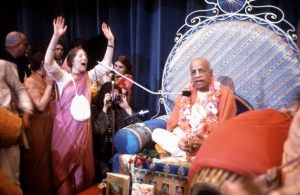SB 4.8.43: Difference between revisions
m (1 revision(s)) |
No edit summary |
||
| Line 1: | Line 1: | ||
{{info | {{info | ||
|speaker= | |speaker=Nārada Muni | ||
|listener=King Dhruva | |listener=King Dhruva | ||
}} | }} | ||
[[Category:Srimad-Bhagavatam - Canto 04 Chapter 08]] | |||
[[Category:Bhagavatam Verses Spoken by Narada Muni - Vanisource|040843]] | |||
<div style="float:left">'''[[Srimad-Bhagavatam]] - [[SB 4|Fourth Canto]] - [[SB 4.8: Dhruva Maharaja Leaves Home for the Forest|Chapter 8: Dhruva Mahārāja Leaves Home for the Forest]]'''</div> | |||
<div style="float:right">[[File:Go-previous.png|link=SB 4.8.42]] '''[[SB 4.8.42]] - [[SB 4.8.44]]''' [[File:Go-next.png|link=SB 4.8.44]]</div> | |||
{{RandomImage}} | |||
==== TEXT 43 ==== | ==== TEXT 43 ==== | ||
<div | <div class="verse"> | ||
snātvānusavanaṁ tasmin | :snātvānusavanaṁ tasmin | ||
kālindyāḥ salile śive | :kālindyāḥ salile śive | ||
kṛtvocitāni nivasann | :kṛtvocitāni nivasann | ||
ātmanaḥ kalpitāsanaḥ | :ātmanaḥ kalpitāsanaḥ | ||
</div> | </div> | ||
| Line 16: | Line 22: | ||
==== SYNONYMS ==== | ==== SYNONYMS ==== | ||
<div | <div class="synonyms"> | ||
''snātvā''—after taking bath; ''anusavanam''—three times; ''tasmin''—in that; ''kālindyāḥ''—in the River Kālindī (the Yamunā); ''salile''—in the water; ''śive''—which is very auspicious; ''kṛtvā''—performing; ''ucitāni''—suitable; ''nivasan''—sitting; ''ātmanaḥ''—of the self; ''kalpita-āsanaḥ''—having prepared a sitting place. | |||
</div> | </div> | ||
| Line 23: | Line 29: | ||
==== TRANSLATION ==== | ==== TRANSLATION ==== | ||
<div | <div class="translation"> | ||
Nārada Muni instructed: My dear boy, in the waters of the Yamunā River, which is known as Kālindī, you should take three baths daily because the water is very auspicious, sacred and clear. After bathing, you should perform the necessary regulative principles for aṣṭāṅga-yoga and then sit down on your āsana [sitting place] in a calm and quiet position. | Nārada Muni instructed: My dear boy, in the waters of the Yamunā River, which is known as Kālindī, you should take three baths daily because the water is very auspicious, sacred and clear. After bathing, you should perform the necessary regulative principles for aṣṭāṅga-yoga and then sit down on your āsana [sitting place] in a calm and quiet position. | ||
</div> | </div> | ||
| Line 30: | Line 36: | ||
==== PURPORT ==== | ==== PURPORT ==== | ||
<div | <div class="purport"> | ||
It appears from this statement that Dhruva Mahārāja had already been instructed how to practice the eightfold yoga system, which is known as aṣṭāṅga-yoga. This system is explained in our Bhagavad- | It appears from this statement that Dhruva Mahārāja had already been instructed how to practice the eightfold ''yoga'' system, which is known as ''aṣṭāṅga-yoga''. This system is explained in our [[Bhagavad-gita As It Is (1972)|''Bhagavad-gītā'']] , in the chapter entitled, "Dhyāna-yoga." It is understood that in ''aṣṭāṅga-yoga'' one practices settling the mind and then concentrating it on the form of Lord Viṣṇu, as will be described in the following verses. It is clearly stated here that ''aṣṭāṅga-yoga'' is not a bodily gymnastic exercise, but a practice to concentrate the mind on the form of Viṣṇu. Before sitting on his ''āsana'', which is also described in [[Bhagavad-gita As It Is (1972)|''Bhagavad-gītā'']] , one has to cleanse himself very nicely in clear or sacred water thrice daily. The water of the Yamunā is naturally very clear and pure, and thus if anyone bathes there three times, undoubtedly he will be very greatly purified externally. Nārada Muni, therefore, instructed Dhruva Mahārāja to go to the bank of the Yamunā and thus become externally purified. This is part of the gradual process of practicing mystic ''yoga''. | ||
</div> | </div> | ||
__NOTOC__ | |||
<div style="float:right; clear:both;">[[File:Go-previous.png|link=SB 4.8.42]] '''[[SB 4.8.42]] - [[SB 4.8.44]]''' [[File:Go-next.png|link=SB 4.8.44]]</div> | |||
__NOTOC__ | |||
__NOEDITSECTION__ | |||
Revision as of 12:27, 10 May 2021

A.C. Bhaktivedanta Swami Prabhupada
TEXT 43
- snātvānusavanaṁ tasmin
- kālindyāḥ salile śive
- kṛtvocitāni nivasann
- ātmanaḥ kalpitāsanaḥ
SYNONYMS
snātvā—after taking bath; anusavanam—three times; tasmin—in that; kālindyāḥ—in the River Kālindī (the Yamunā); salile—in the water; śive—which is very auspicious; kṛtvā—performing; ucitāni—suitable; nivasan—sitting; ātmanaḥ—of the self; kalpita-āsanaḥ—having prepared a sitting place.
TRANSLATION
Nārada Muni instructed: My dear boy, in the waters of the Yamunā River, which is known as Kālindī, you should take three baths daily because the water is very auspicious, sacred and clear. After bathing, you should perform the necessary regulative principles for aṣṭāṅga-yoga and then sit down on your āsana [sitting place] in a calm and quiet position.
PURPORT
It appears from this statement that Dhruva Mahārāja had already been instructed how to practice the eightfold yoga system, which is known as aṣṭāṅga-yoga. This system is explained in our Bhagavad-gītā , in the chapter entitled, "Dhyāna-yoga." It is understood that in aṣṭāṅga-yoga one practices settling the mind and then concentrating it on the form of Lord Viṣṇu, as will be described in the following verses. It is clearly stated here that aṣṭāṅga-yoga is not a bodily gymnastic exercise, but a practice to concentrate the mind on the form of Viṣṇu. Before sitting on his āsana, which is also described in Bhagavad-gītā , one has to cleanse himself very nicely in clear or sacred water thrice daily. The water of the Yamunā is naturally very clear and pure, and thus if anyone bathes there three times, undoubtedly he will be very greatly purified externally. Nārada Muni, therefore, instructed Dhruva Mahārāja to go to the bank of the Yamunā and thus become externally purified. This is part of the gradual process of practicing mystic yoga.